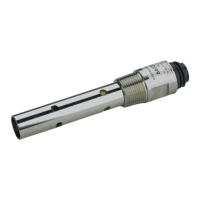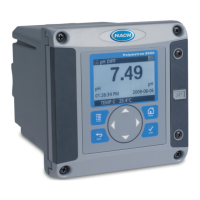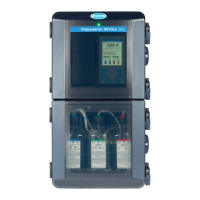Option Description
LOG SETUP Sets the time interval for data storage in the data log
—5, 30 seconds, 1, 2, 5, 10, 15 (default), 30,
60 minutes.
RESET DEFAULTS Sets the configuration menu to the default settings. All
user-defined settings are lost.
Adjust the T-factor for non-standard cable lengths
When the sensor cable is extended or shortened from the standard 6 m
(20 ft), the resistance of the cable changes. This change reduces the
accuracy of temperature measurements. To correct for this difference,
calculate a new T-factor.
Note: This procedure applies only to sensors with a PT1000 temperature element.
Sensors with a PT100 temperature element are less accurate.
1. Measure the temperature of a solution with the sensor and with an
independent, reliable instrument such as a thermometer.
2. Record the difference between the temperature measured from the
sensor and from the independent source (actual).
For example, if the actual temperature is 50 °C and the sensor
reading is 53 °C, the difference is 3 °C.
3. Multiply this difference by 3.85 to get an adjustment value.
Example: 3 x 3.85 = 11.55.
4. Calculate a new T-factor:
• Sensor temperature > actual—add the adjustment value to the T-
factor on the sensor cable
• Sensor temperature < actual—subtract the adjustment value from
the T-factor on the sensor cable
5. Enter the new T-factor in the Configure, Temp Element menu.
Calibrate the sensor
About sensor calibration
During calibration, data is not sent to the datalog. Thus, the datalog can
have areas where the data is intermittent.
Zero calibration procedure
Use the zero calibration procedure to define the unique zero point of the
conductivity sensor. The zero point must be defined before the sensor is
calibrated for the first time with a reference solution or process sample.
1. Remove the sensor from the process. Wipe the sensor with a clean
towel or use compressed air to make sure the sensor is clean and
dry.
2. Push the MENU key and select Sensor Setup, [Select Sensor],
Calibrate.
3. Push ENTER to select Zero Cal.
4. If the passcode is enabled in the security menu for the controller,
enter the passcode.
5. Select the option for the output signal during calibration:
Option Description
Active The instrument sends the current measured output value during
the calibration procedure.
Hold The sensor output value is held at the current measured value
during the calibration procedure.
Transfer A preset output value is sent during calibration. Refer to the
controller user manual to change the preset value.
6. Hold the dry sensor in the air and push ENTER.
7. Review the calibration result:
• Pass—the zero point is set.
• Fail—the value is outside of accepted limits. Make sure the sensor
is dry and repeat the zero calibration procedure. Make sure that
the cause is not the digital extension cable or a lot of electronic
noise.
8. If the calibration passed, push ENTER to continue.
9. For the sc100 controller, go to step 12.
10. If the option for operator ID is set to Yes in the Calibration Options
menu, enter an operator ID. Refer to Change calibration options
on page 14.
English
11

